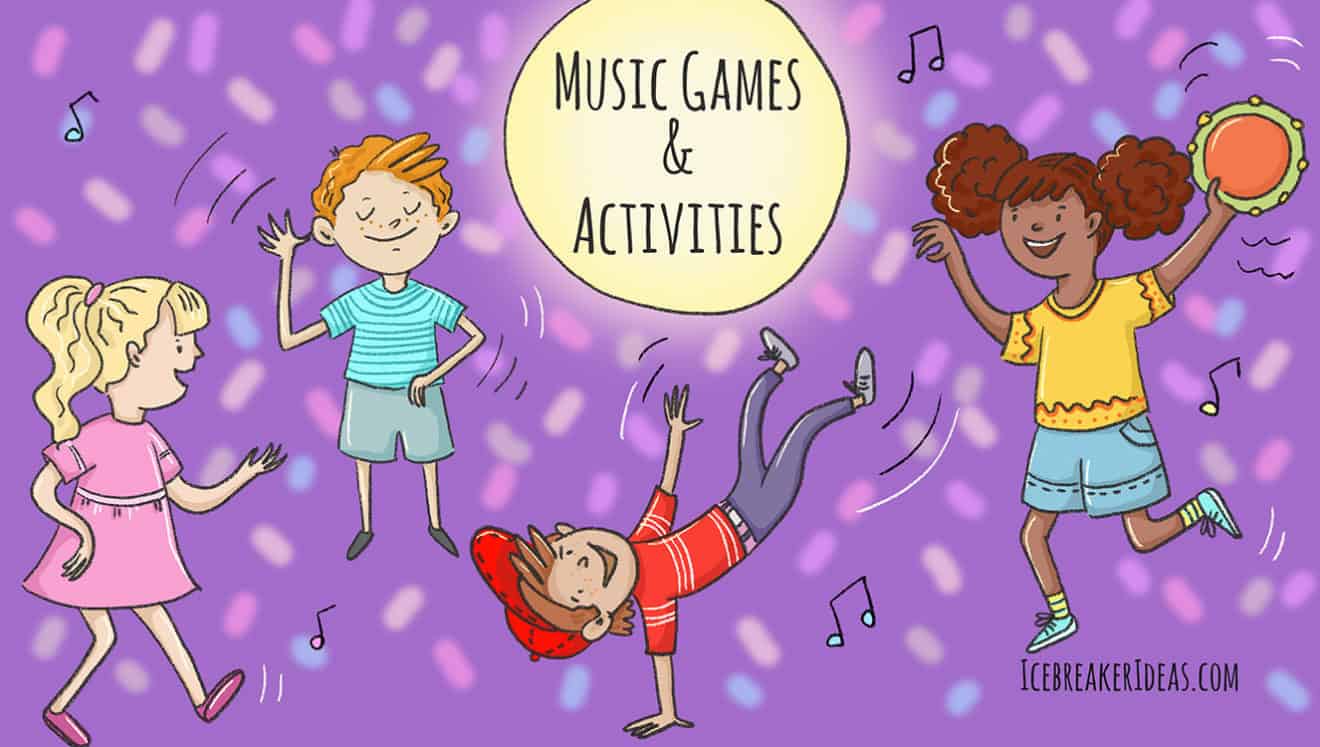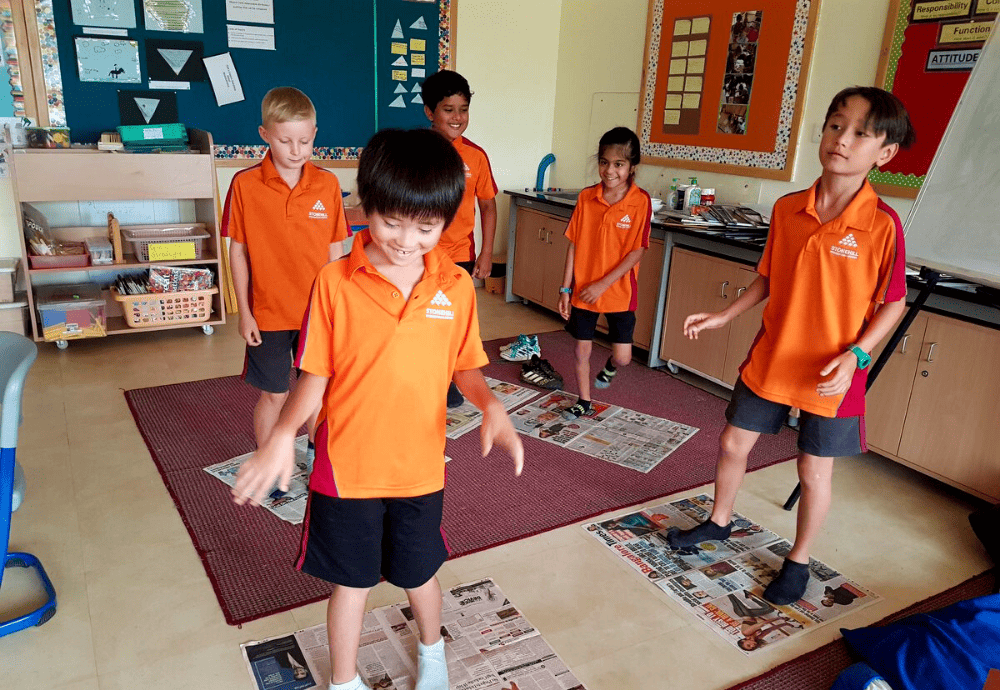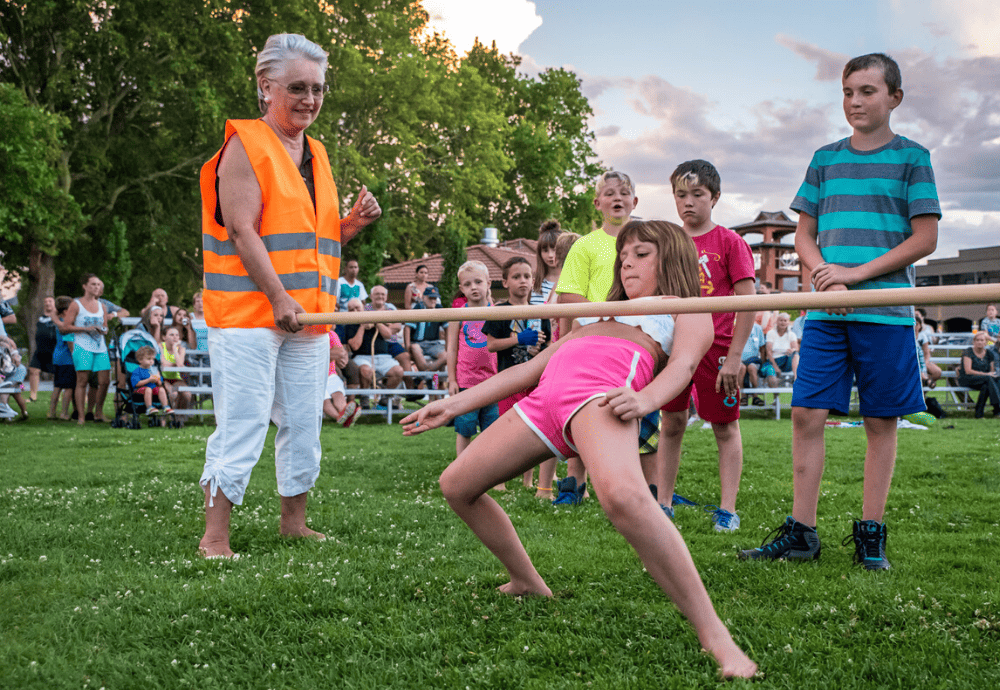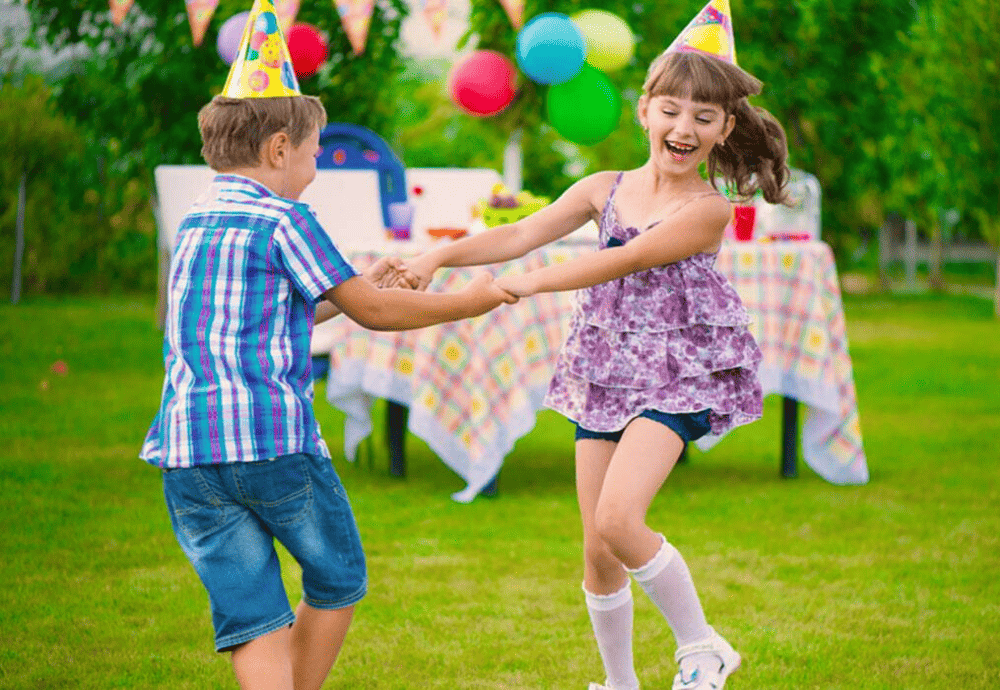Music games for kids always provide fun and excitement. In this article, we have presented some old favorites and some new ideas for using music to increase knowledge and build musical skills. We have included games for younger and older children, but most of the games can be adapted to suit any age group. Remember, any childhood game can be more fun with the addition of music.
Table of Contents
Music games can help a child develop physically and psychologically in many ways, including:
- Improving coordination skills and sense of timing
- Increasing self-confidence
- Enhancing the social skills
- Encouraging participation in group activities.
- Improving motor skills
- Increase fun and enjoyment.
- Improving verbal communication
We begin this article with a list of fun music game especially suited for classroom environment. We further provide musical games specifically for elementary and middle school students. Finally, we have a selection of music activities, many of which provide physical as well as mental stimulation. All of these music games and activities have one thing in common – they are fun!
Music Games for the Classroom
Playing music games is so much fun in the classroom. They provide a change of pace, provide exercise – both physical and mental, and actually aid learning. The benefits of using music games for the classroom include:
- Music helps children learn basic skills.
How to recite the alphabet, count, and pronounce words all work well with a music game. - Music helps children’s literacy and communication skills.
Children can learn new vocabulary words and develop fluency of speech by playing music games in the classroom. - Music actually improves cognition.
Research has disclosed listening to music can change how the brain works by dramatically improving memory, concentration, spatial intelligence, thinking skills, and other cognitive capabilities.
Musical Chairs
The classic music game provides non-stop fun. Place two rows of chairs back to back with enough chairs for each kid. Have the children begin this game seated. Instruct them to move around the chairs when the music plays and take a seat when the music stops. Each time the music stops, remove one chair. One of the kids will not be able to find a seat and will be out of the game each time the music stops. The winner is the last child left in the game.
Creative Composing
This cool game is great for improving your students’ memory. Give each child a sheet of paper and colored pens or pencils. List the following on the board:
- A circle = hit your desk with the palm of your hand
- A square = clap your hands
- A star = snap your fingers (If a student cannot do this, have them pat their left palm with the first two fingers of their right hand.)
- A triangle = stomp your foot
Depending upon the height of your students, you can either have them sit at or stand next to their desks. Let each child create a song using the symbols and then write it on the board for the others to follow.
Musical Gossip
You can use the symbols from the previous game for a musical game of Gossip. Line the students up and have the student in the back tap out a phrase of the rhythm they composed on the back of the student in front of them. The tapping keeps passing forward and the student at the front of the line writes the rhythm on the whiteboard. It is fun to see how close they are to the original rhythm. You can play this as a team game with four or five students on each team and the first team to correctly repeat the rhythm wins the game.
Paint to Music
Another non-complicated classroom music game combines listening and art. Give the children a large piece of paper, tempera paint, a jar of water to rinse the brushes, and few brushes in various sizes. Play music of varying beats, volume, and styles. Have the kids paint the way the music makes them feel. When they want a new color or after a set amount of time, have the kids pass their paint color to the right so that each child can use multiple colors.
Artistic Relay
Another fun drawing game also involving music and coloring, artistic relay gives kids an opportunity to express themselves a new and exciting way. Provide each student with a sheet of paper and colored pencils. Tell your students to begin drawing when the music plays and stop drawing when the music stops. Then each student leaves their desk, moves to another desk and draws on that sheet until the music stops again. Continue until you think each student has had an opportunity to draw on their classmates’ paper. Then have all the students return to their own desk and see what the picture looks like.
Elementary Music Games
By utilizing music games to teach elementary school children, learning becomes fun. Children remember music easily and make connections between what they hear and what they see. Elementary music games reinforce learning and provide a way to impartially involve students in learning activities.
Musical Hot Potato
This fun musical game is great as an icebreaker on the first day of school to help children get to know each other. Write five questions on the whiteboard designed to help students get to know one another. We suggest the following, or choose your own:
- What is your favorite food?
- What is your favorite thing to do for fun?
- Do you have a pet? If so, what kind? If not, what is your favorite animal?
- What is your favorite school subject?
- What is your favorite color?
Have the children sit in a circle in chairs or on the floor. Have an object to pass – a ball or small stuffed animal works well – and music to play. Pass the object while the music is playing and when it stops, whichever child has the object answers one of the questions on the whiteboard. Continue until most of the children have answered at least three questions.
Musical Dress-up
This musical game may not provide any educational value, but it is guaranteed to provide fun! Perfect for a rainy day when the students must spend time indoors for recess.
Purchase clean, used, small adult clothing and accessories at a thrift store or have parents donate some. Arrange the classroom chairs in a circle or have the students sit in a circle on the floor. Start some lively music and pass a large bag of clothing and accessories around the circle. When the music stops, the child with the bag chooses an item and puts it on. When the bag is empty, the child with the most unusual outfit wins this game.
Musical Chairs Learning
This variation of regular musical chairs works in the elementary classroom to encourage reading and to teach basic facts, especially for math. Begin by having your students sit in a circle in chairs or on the floor. Choose an educational activity you want each child to complete. Some suggestions are:
- Read a paragraph from a textbook.
- Work a math problem.
- Spell a vocabulary word.
- Write a sentence on the whiteboard using two adjectives.
Start the music. The children walk around the chairs and when the music stops, they find a seat. The child without a seat must complete the designated activity.
Paper Dance
A paper dance is fun and teaches hand-eye coordination. You will need a box of tissues or pieces of lightweight paper. Each child places a tissue or paper on their head and dances to music. The goal is to move without losing the paper. If it slips from their head, they may put it back on and continue dancing. However, if the tissue hits the floor, the kid is out. The last student dancing with the paper still on their head is the winner.
Musical “Cake” Walk
Lay out pieces of colored construction paper on the floor, one for each student, minus one. Begin playing music and have the students step from paper to paper until the music stops. The child without a place to stand is out. The last child standing wins this fun game.
Music Games for Middle School
Music is such an important part of a preteen and teen life. Their love of music translates well into learning and fun games in the classroom. In order to get the middle school student excited about learning, try these interactive music games for middle school to reinforce facts and concepts learned in class.
Rap Away!
Rap is a great music form for teens to compose, as they do not need to read music or understand how to write a musical composition in order to produce a song. Rap uses ABBA and AABB rhyming schemes, so you might wish to start by sharing those with your students. You can also suggest some topics if you wish. Make sure you set some guidelines as far as acceptable content and vocabulary; remind your students to keep the content clean to avoid problems. Split your students into groups of three or four and have them write a short rap. Set a time for the students to complete their compositions and then let them share with the entire class.
The Limbo
You will need a long stick; a mop or broom handle works well. The goal is to dance under the stick while leaning back. Each time the kids takes a turn dancing under the stick, they lean lower back and down. The goal is to see, “How low can you go?” A player who touches the stick is out. The winner is the kid able to dance the lowest under the pole.
Dance Island
This game requires the use of spatial intelligence and balance and works well in the classroom, gym, or activity area. Clear a space and lay out pieces of newspaper on the floor. Play music and have your middle school students dance on their piece of paper. When the music stops, they are to move off the paper, fold it in half, and prepare to dance when the music starts. Each time the music stops, they must fold the paper in half again. Teens are eliminated each time they step off the paper while the music is playing. The last child dancing on the folded piece of paper wins.
Karaoke Contest
All you need for classroom karaoke is a sound system with a microphone and songs your middle school students know. Write down names of familiar tunes and put them in a box or basket. If your middle students are hesitant to perform in front of others, divide them into pairs. Let each team of two draw a song from the box or basket and sing it. Check out YouTube for karaoke songs. You can also purchase karaoke software to use on your classroom computer.
What Do You Hear?
This activity is wonderful for teaching students how to write descriptive words and phrases. It also teaches them to concentrate and listen very carefully.
Students love to write on a whiteboard. Provide several dry erase markers in bright colors. You will play various pieces of music and have the students take turns doing one or more of the following for each song:
- Write words to describe what they hear.
- Write words they hear repeated in a song.
- Write a noun (pronoun, verb, preposition, adjective, or adverb) they hear in the song.
You can clean the board after each song, a few songs, or all the songs – your choice. You can use the words they have as a springboard for creative writing if you wish.
Music Activities for Kids
Music activities involve movement of a kid’s body. Our selection of music activities for kids often require additional equipment, props, or music players. We have included some familiar favorites as well as some creative new ways to play actively with music.
Silly Dancing
Begin by designating a play area large enough for kids to dance. Remove any obstacles and make sure kids have room to swing their arms. You will need a selection of props – ribbons and scarves, hats, stuffed toys, plastic flowers, etc. Set up a music player and spread your props out on a table.
Explain to the kids that you will start playing music and when you do so, they are to select a prop from the table and begin dancing to the music while using the prop as an accessory. Whenever the music stops, they are to return the prop to the table. When the music begins again, they must choose another prop for dancing. You can keep this game going as long as the kids show interest.
Pass Fast
A fun activity for learning cooperative play, this simple game only requires a ball and some music. Have the children sit in a circle, either on the floor on in chairs. Pass a ball (or a stuffed animal) around the circle until the music stops. At this point, you can choose one of two options:
- Whoever has the ball is out.
- You start the music again and the ball is passed in the opposite direction.
Freeze
All you need for this fun activity is a music player and space to dance. Clear a space large enough for all the children to be able to dance around without bumping in to each other. Play music and let the kids dance. Direct the kids to freeze when the music stops. They must remain perfectly still for one minute. Any kid who moves, laughs, or even changes facial expression is out. When you turn the music back on, the kids start dancing again and freeze when the music stops. Continue until only one player is left – the winner of this fun game.
In this article, we have presented music games and activities for kids in different age groups to be used in a variety of environments. Use our music games for kids at birthday parties and holiday celebrations. When families get together, use one of our musical games to keep kids engaged in age-appropriate activities. Music games work especially well when adults want some time alone and need to avoid boredom for the kids.
Kids love music and combining music with games provides both physical and intellectual activity. When you use our music games for kids try several different ones to find their favorites. Make sure all of the kids are involved, and play only as long as the children are actively engaged in the game.
Play away and have fun!
Susan majored in English with a double minor in Humanities and Business at Arizona State University and earned a Master’s degree in Educational Administration from Liberty University. She taught grades four through twelve in both public and private schools. Subjects included English, U.S. and world history and geography, math, earth and physical science, Bible, information technologies, and creative writing.
Susan has been freelance writing for over ten years, during which time she has written and edited books, newspaper articles, biographies, book reviews, guidelines, neighborhood descriptions for realtors, Power Point presentations, resumes, and numerous other projects.





Thank You for sharing all your music activities..